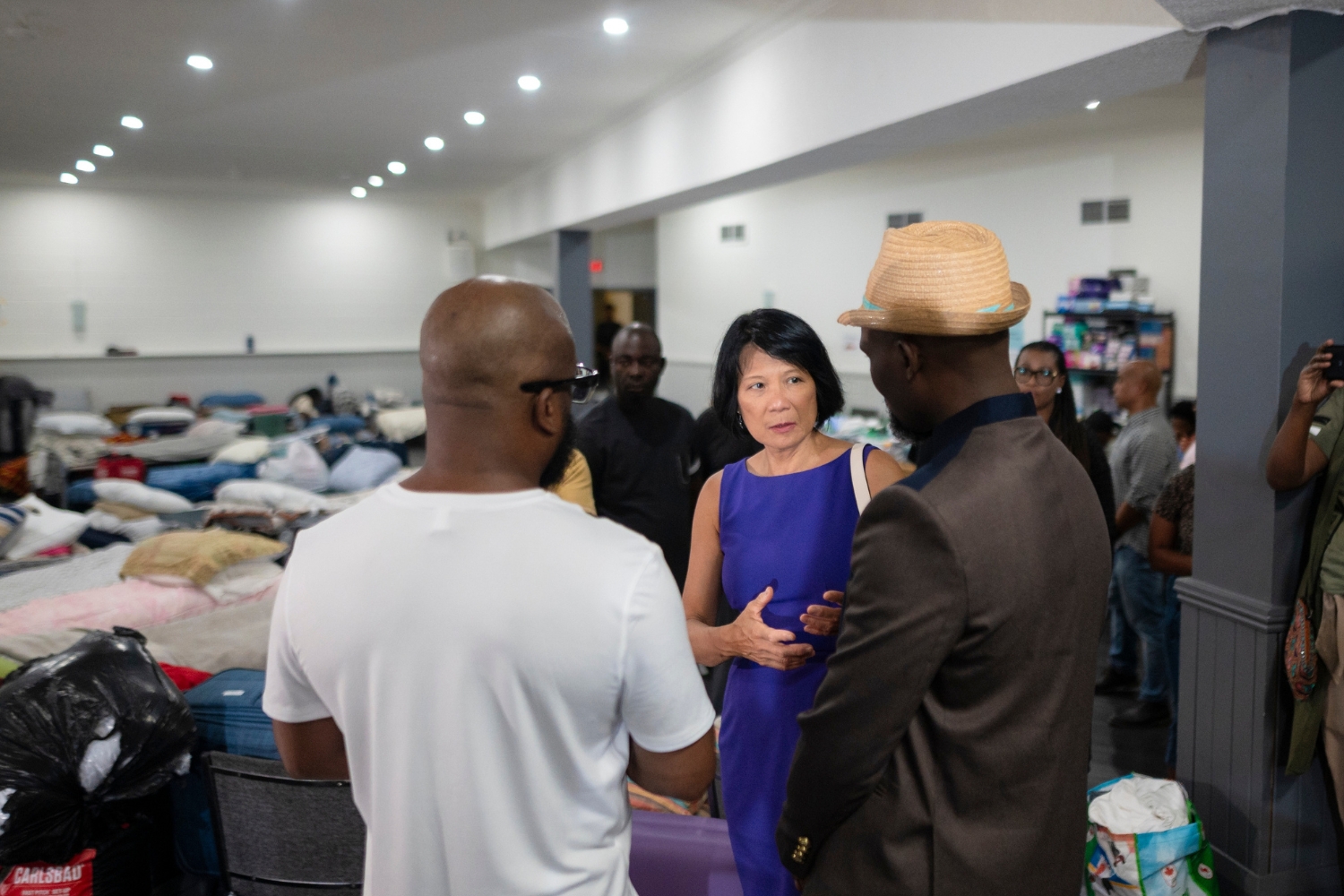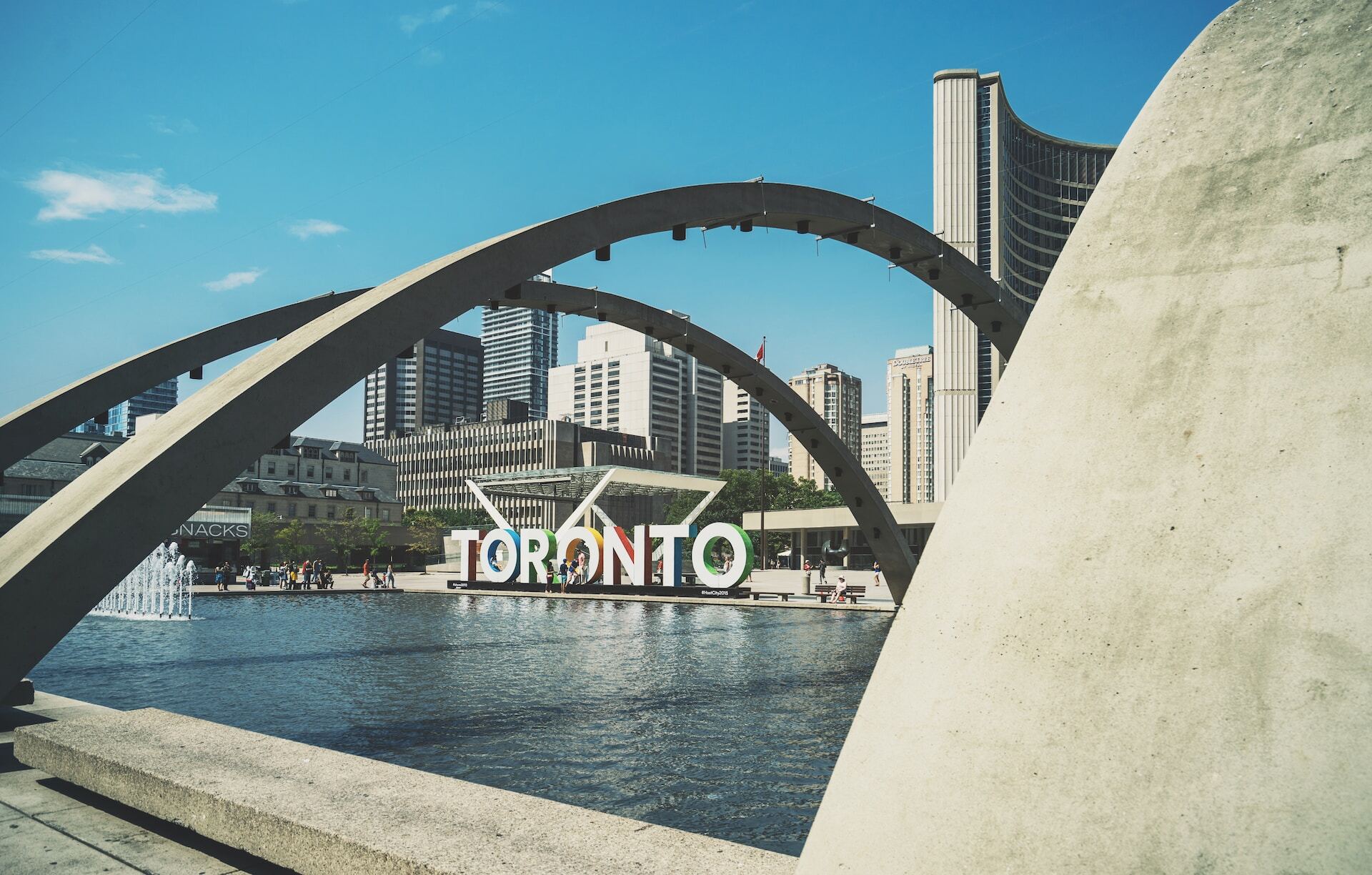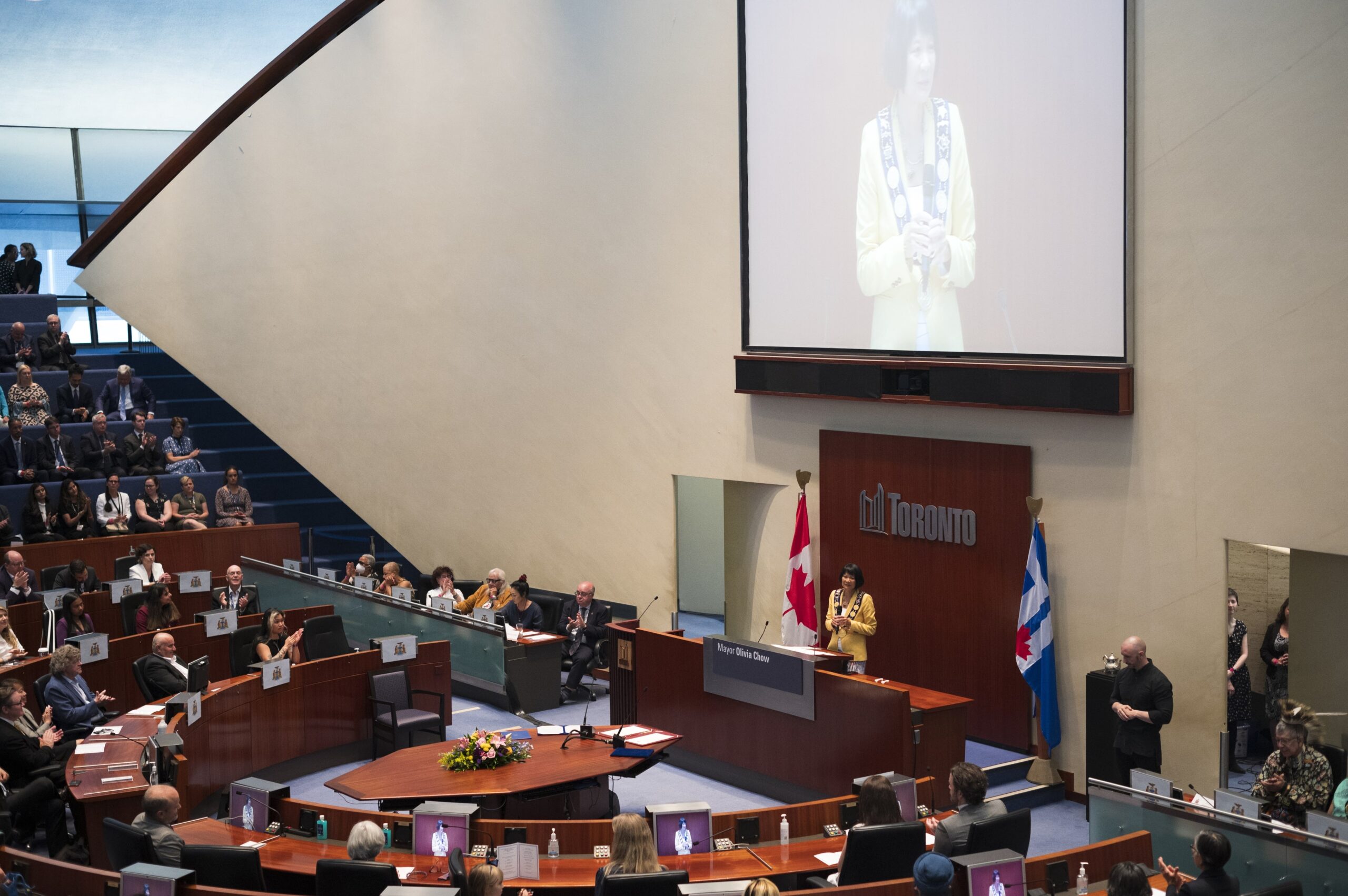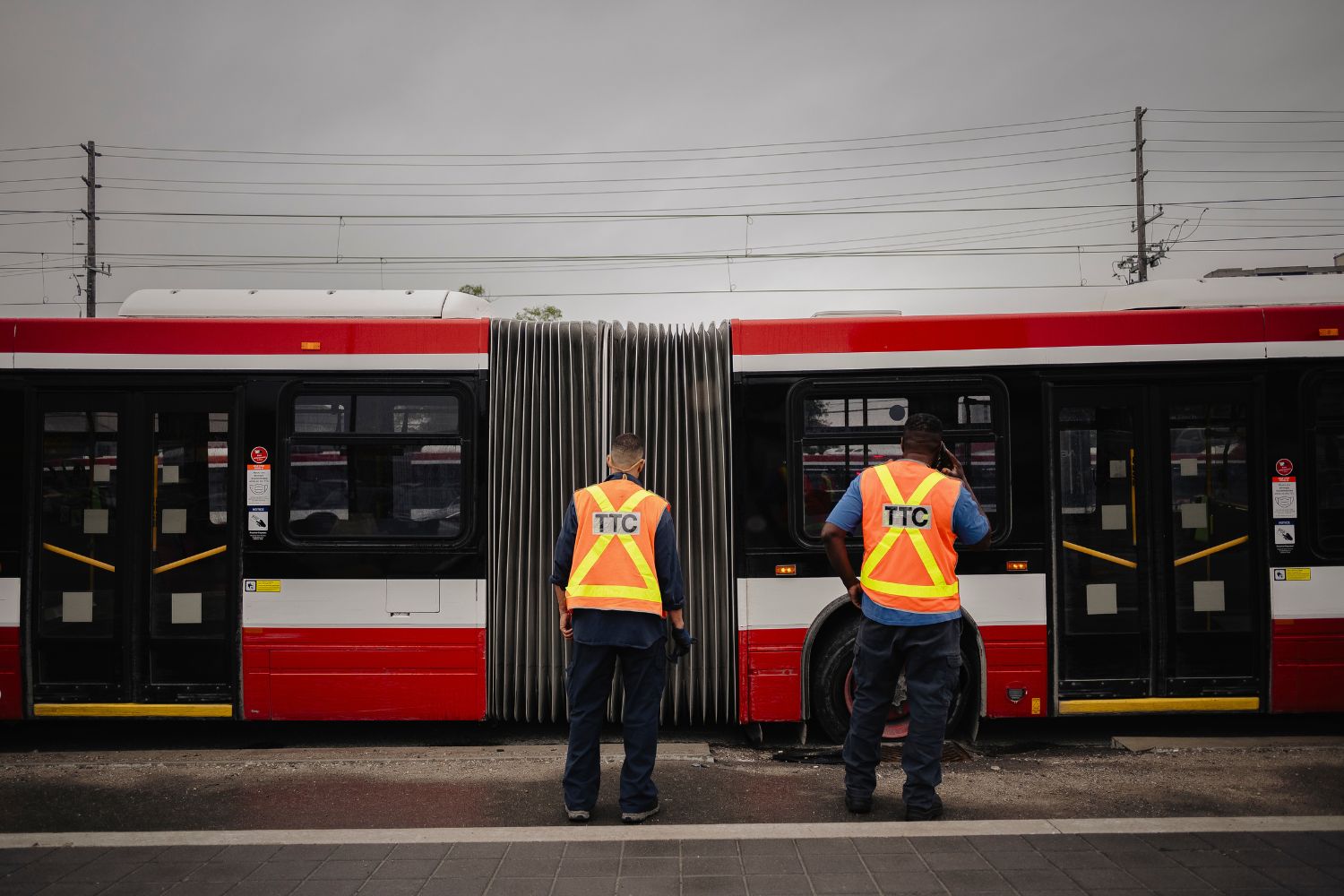
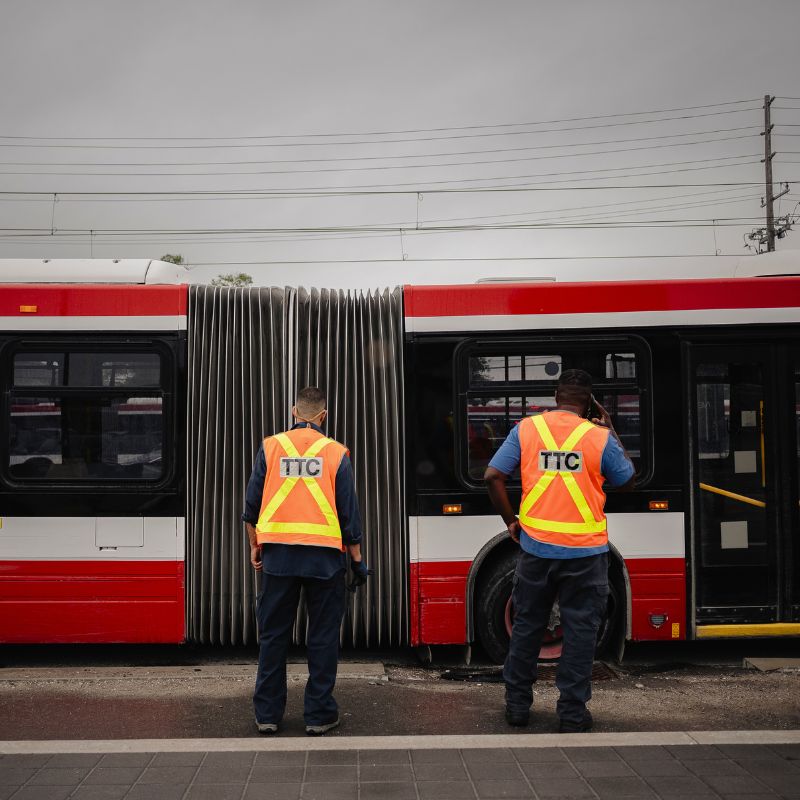
The first 100 days are crucial for a new mayor. In our new column, we’re following Olivia Chow’s first months in office—tracking her progress (or lack thereof) on election promises, who’s supporting and who’s impeding her, and everything else you need to know from City Hall.
For Jamaal Myers’ first meeting as TTC chair, he chose to make a symbolic gesture—relocating the meeting from City Hall to Scarborough Civic Centre. The iconic building, retrofuturist but slightly shabby, just turned 50. (When its architect, the late Raymond Moriyama, visited in 2015, he was dismayed by the civic centre’s unused potential as a public space.)
Myers, the first-time Scarborough North councillor, is a longtime transit advocate. He’s a TTC rider, only the second Black TTC chair (the first was 91 years ago), and a former TTC employee. “I spent three summers as a student working the overnight shift, cleaning trains at Greenwood Yard to pay for university,” he mentioned in his opening remarks.
Olivia Chow’s appointment of Myers, and his choice of venue, both signal an intent to recentre voices and communities long sidelined and neglected in Toronto transit policy. Their messaging has been optimistic, but they have to work with what they’ve inherited: a callous law enforcement-centric approach to safety, long-neglected infrastructure, and lacklustre service. Even if they are successful, it takes more than a few months to overcome this kind of institutional inertia.
Shelter, or shuttling people out of sight?
What should the TTC do about homeless people in the transit system? With a social safety net frayed from decades of neglect and the sudden shock of the pandemic, the TTC increasingly finds its role overlapping with social services and public health. In the first few months of Chow’s mayoralty, its approach is already evolving.
The TTC’s safety measures were rolled out in January 2023 in response to a number of violent attacks, the rise of homelessness leading to an increasing number of people using the TTC for shelter, and the increase in opioid overdose deaths. Over the next few months, the TTC hired new staff and contractors, including police officers (temporarily), security guards, more special constables, and community safety ambassadors. The TTC also extended their preexisting agreement with the Shelter, Support & Housing Administration (SSHA) to add more Streets to Homes workers and extended the Multi-Disciplinary Outreach Team pilot project for people with complex needs. More recently, hundreds of TTC employees, including special constables, have been provided with and trained to use naloxone kits.
In February 2023 and June 2023 reports, transit advocacy group TTCriders strongly criticized the TTC’s approach for its emphasis on law enforcement and deterring unhoused people. Speaking to The Local, TTCriders’ August Puranauth says the September 20 announcement of 178 new staff, primarily front-line workers, shows the agency is moving in the right direction: “Since Olivia Chow was elected, we’ve seen her keep the promise of making transit safer for all—taking approaches that are more inclusive of everyone, and not just the privileged few who will call for more policing in the system.”
Local Journalism Matters.
We're able to produce impactful, award-winning journalism thanks to the generous support of readers. By supporting The Local, you're contributing to a new kind of journalism—in-depth, non-profit, from corners of Toronto too often overlooked.
SupportIn May, the TTC, working with the SSHA, began the “Getting Back to Transit (Move Along)” initiative to discourage people from using the TTC for shelter. Part of this, TTC CEO Rick Leary explained to the TTC board, consisted of “sweeping the stations” at the end of the night, directing anyone sheltering in the stations to head down to a hub at Union or Spadina where Streets to Homes has a dedicated space set up. Until now, when necessary, Streets to Homes workers have been booking taxis to send people to warming centres and shelters with available space. However, this ad-hoc system easily gets backlogged. This winter, the TTC proposes using several decommissioned and reconfigured buses to transport people and, if absolutely necessary, provide temporary shelter while waiting for space to free up. TTC staff are adamant that the buses are not intended to be used as shelters: they are primarily for transportation, and people will be allowed to stay on them for longer periods only in dire circumstances.
It’s not a new idea—this summer, a Vaughan church already adapted buses as shelters to house asylum seekers. The TTC’s plan was first floated in June.
At the September meeting, several board members had questions: Will people on the buses be given food and drink? (Yes.) Who will staff the bus? (TTC and SSHA.) Will people know where they’re going beforehand? (Yes.) What if there isn’t room in shelters? (Non-answer.) Shouldn’t the city be paying for it, not the TTC? (That’s not a question staff can answer, sir.) The board did vote to support the plan, but also requested TTC staff provide a more detailed update at October’s meeting and consult with SSHA, who are also working on winter preparations.
The obvious problem is that Toronto’s shelter system is virtually always over capacity. Spaces, when they are available, may be scattered across different locations. It is unclear how, for an unhoused person, sitting on a bus would be more convenient than staying in Union Station, where there is already convenient access to food, drink, and washrooms. “It seems like a very temporary bandaid,” says Puranauth, “and it doesn’t really address the root causes of people taking shelter in the TTC system. If they don’t comply, they could be forcibly removed or they could even be arrested. So it’s not this compassionate approach that the TTC touted it to be.”
Even if there is room, for many unhoused people shelters are unsuitable and even downright unsafe. “Some people have concurrent mental health conditions where it is almost impossible for them to be in a group setting with other people,” says Dua Hyjazie, a harm reduction outreach worker who has experienced homelessness herself.
What are some better ways the TTC could genuinely improve transit users’ well-being? Hyjazie points out that, while there are various services and supports available during the day, people with nowhere else to go are uniquely vulnerable at night. “There’s three or four groups of outreach teams that will go out during the daytime. If one of those groups would go at night, that would be enough to fill the gap.”
Puranauth notes that the TTC’s publicly available community safety metrics are vague, lumping together incidents regardless of type or severity. “If you don’t know what kinds of incidents are happening, then how do you know what kind of response it really needs?…We want to see more detailed metrics on safety. We want to know who’s feeling unsafe, why they are feeling unsafe, what kind of incidents are going up and which are going down, and then respond in an appropriate way that’s inclusive of everyone’s safety. The way it’s currently done isn’t like that, and it’s not very transparent.”
Ultimately, however, the TTC is in the unenviable position of addressing crises that are beyond its power or purview to fix. It’s not alone; as TTCriders’ safety report describes, transit systems across North America are also currently experimenting with similar community safety programs involving various combinations of non-enforcement front-line personnel, law enforcement and security guards, and partnerships with social services. It parallels how libraries across Canada (and, indeed, North America as a whole) have found themselves in the role of social services providers.
Derailed
Another item too important to omit here was the update on the SRT derailment that caused the line to be shut down in July, months before its planned closure.
The investigation traced the problem to the bolts holding down the broad, flat central rail that propels the SRT cars. Originally, the bolts were cast in concrete. As the aging system required retrofitting, replacement bolts were set in epoxy. However, in 2016 the TTC learned this solution was ineffective. They were replaced by bolts fixed in place mechanically, like self-anchoring bolts in walls. On the section of rail that came loose, some bolts became loosely anchored and others fractured. The rails are regularly checked visually, but these faults are not easily visible.
The only other systems in North America that use this technology are Vancouver and Detroit. Detroit’s PeopleMover had a derailment in 2015 after a bracket dislodged; Vancouver’s SkyTrain derailed in 2022 due to a switch’s bolts shearing off. It would be interesting to learn how the TTC took these incidents into account for maintaining the SRT—and conversely, how (or whether) Detroit and Vancouver have been doing things differently. (In their presentation, TTC staff have said they will share the investigation’s findings with the other transit agencies.)
Leary warns that without funding from other levels of government, having to shut more things down is a possibility. “My nervousness is the Line 2 trains and the signal system that’s getting very, very frail,” Leary told the TTC board. “Shutting the SRT down was a message, and then having [the derailment] happen was even more of a message.”
What’s next
- Chow has been doing some inter-governmental diplomacy. On September 18 she met with Doug Ford, where they announced the creation of a working group to find a fiscal new deal for Toronto, with an update expected some time in November. On September 27, she met with federal finance minister Chrystia Freeland. The provincial and federal governments have spent years telling the city to ask the other for money. If the federal government agrees to come to the table, it could potentially break the deadlock that contributes to Toronto’s structural financial shortfall.
- Chow also suggested Exhibition Place’s Better Living Centre as an alternative site for the Therme spa the province plans for Ontario Place. While the Exhibition Place CEO is amenable to the idea, Therme and the province are not. However, it’s not necessarily set in stone: City Planning is still working on their response to the development application, Chow has also declared she will challenge in court, and the province’s Greenbelt reversal has given opposition groups hope that public pressure could still force Ford to revisit more decisions.
- Beefing up the new and somewhat underwhelming Vacant Home Tax was one of Chow’s campaign promises; Executive Committee has just recommended various changes to the program.
- City real estate agency CreateTO gets an update on HousingNow progress, the long-delayed program to develop affordable housing on city-owned land. In May, Council approved various options to “unstick” the process.
- City Council meets next week; the agenda will be out Thursday.


